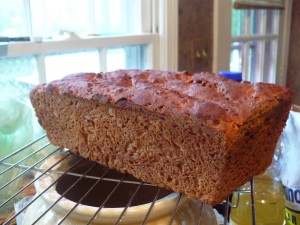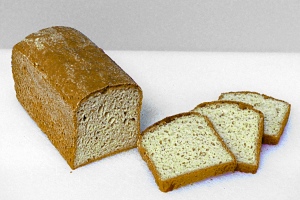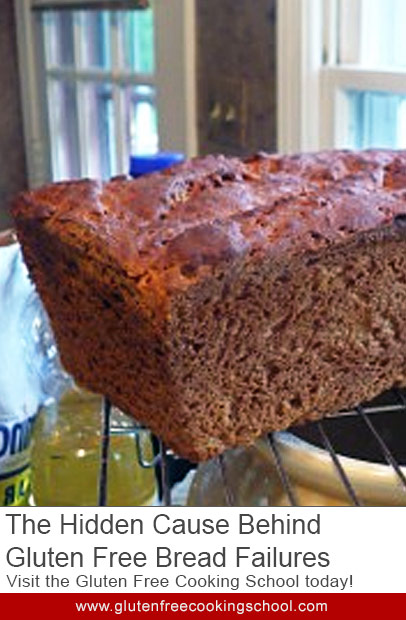Gluten free bread is more of a science than an art and precision matters. In my gluten free cooking classes we weigh all of the flours to ensure that the we’re using the same amount each time. We use one thermometer to monitor the oven temperature, and a separate thermometer to determine when the bread is done.
Measuring the weight of ingredients and the temperature of the oven and bread may seem nit-picky if you haven’t tried it, but it pays off in the end when you get a loaf of bread that turns out beautifully. And the weighing and temperature taking does not really add any work at all.
The Hidden Cause Behind GF Bread Failures
Over the past two weeks, I’ve discovered a new hidden cause of Gluten Free Bread failures: the size of your loaf pan.
Even the most precisely measured dough will not turn out well if the size of your loaf pan or bread machine pan is different than the pan that the recipe writer used. If the pan that you use is to small, then your dough will rise too high and may collapse before the crust has set. If your pan it too large, then you’ll end up with a short loaf, or a loaf that has large air bubbles.
The shape of the loaf pan matters too. A loaf pan with tall, straight side will give you a higher loaf than a pan with angled sides.
Instructions
A Case Study In Loaf Pans
The pictures below show the same recipe cooked in two different pans.


The bread pictured above on the top is my “No Corn For Me Gluten Free, Corn Free, Xanthan Gum Free Loaf” baked in my 10″x5″x3″ pan. The picture on the bottom is the same recipe baked in the 9x4x4 Pullman pan. It’s quite a difference!
The first photo was taken when I was developing one of my corn-free, Gluten Free Bread Recipes. I knew the consistency of the dough was right. I was confident of my measurements. Yet, I was still not getting the high, tall loaf that I wanted and that I got from my Finally, Really Good Gluten Free Sandwich Bread recipe.
I asked a professional baker who was learning to bake gluten free bread to test the recipe and refine it for me. After 6 months of testing, he came back and said that the recipe was just fine as I’d written it. It worked perfectly in his 9x9x4 Pullman pans.
What Size Pan Do You Need?
Did you think a loaf pan was a loaf pan? I must admit, I had not given much thought to this matter. However, a quick search on Amazon reveals that there are a multitude of different pan sizes. Some pans are simply labeled small, medium, or large. Others state that they are for 1.5 LB loves. Others give specific height, length, and width measurements.
Of all of these ways of describing the size of a loaf pan, only the specific measurements are any help at all. Loaves of bread vary in weight depending on the flours used, and gluten free loaves tend to weigh more than similarly sized loaves of white wheat bread. This renders the differentiation between 1.5 and 2.0 pound loaves meaningless.
The best loaf pan for you will depend on the bread recipes that you’re using, because you want to use the same size pan that the recipe writer used. Unfortunately, that information is not given in most recipes, so you may choose to keep a few different pan sizes so that you can experiment with smaller or larger pan sizes. That’s a pain in the rear, I know, so I’m going through my bread recipes this week and adding a note about the recommended loaf pan size!
I use this Chicago Metallic Commercial II Traditional Uncoated 1-1/2-Pound Loaf Pan that measures 10″x5.5″x3″ for my Finally, Really Good Sandwich Bread Recipe and Irish Cousin Gluten Free, Yeast Free Loaf, which are both included in my Gluten Free Bread 101 class.
However, I am planning to purchase this USA Pans 9 x 4 x 4 Inch Pullman, Aluminized Steel with Americoat.
Pullman pans were invented for Pullman train cars. The straight sides of the pan allowed the Pullman train car personnel to store 3 loaves of bread in the same area where they had previously only been able to fit 2. If you’re family is yearning for the familiar shape of a commercial loaf, this may be what you need. There is also a larger 9 x 13 x 4 pan size that I’d love to experiment with. I’ll have to scale up my recipes first, but the resulting loaf would be around the same length as a loaf of store-bought white wheat bread.

Frances,
I think you meant to say you were going to experiment with a 13X4X4 pan. I was having difficulty with my bread last year. I went to a cake supply shop and found a 15.5X4X4 straight sided aluminum pan in which I triple my recipe and have had good luck. That is if I bake it before it reaches the top of the pan or it creates a huge deep valley down the middle as it cools.
Jack Teddlie
Jack Teddlie » You are correct. Thanks for pointing out my error; I’ve corrected it now. I’m very glad to hear that the longer pan works. It would really be nice to be able to bake a loaf that would provide more than one meal for my family of five. After all, my children are still relatively little. The 9″ loaf will just not be enough once my boys hit the teenage years.
Well.. I was going to edit the article, but the technology to do that is not cooperating with me right now. So until I get edit done, it is a 13x4x4 pan (or larger) that I would like to experiment with…in addition to a 9x4x4 pan.
I need help. My Pullman bread loaf always has a valley, it sinks while cooling. Now, the bread is perfect inside, I don’t want to change that.
Interesting article. It does make me think that the gluten free stuff is even more complicated than I already think it is. I am not a fan of the white starchy flours used in the gluten free items I have tried so far. Is there such a thing as whole grain gluten free flours?
Wendy » In a way it is more complicated, but you can get to a point where you have a good mental grasp of all of the variables and then it doesn’t seem so bad. Thankfully, good measurement practices + well-written recipes + watching someone else do it can get you to making good gluten free bread in a just a few hours.
Of the flours that I use in my bread mix, I believe that the Bob’s Red Mill brown rice flour and sorghum flours are both technically whole grain flours. I don’t have the bags in front of me right now (and I would end up waking my kids way too early if I tried to look), but I think the masa harina is too. You can’t get away from using some starches in the flour mix, but I did try to pick up my other flours with good nutrition in mind. Here’s an post about the nutritional analysis for the flour mix that I generally make at home: http://www.glutenfreecookingschool.com/gluten-free-flour-mix-nutritional-analysis/
Thanks Mary Frances. I will have to explore your site more. 🙂
Hi. I have considers taking your bread class but I am afraid most the recipes will be useless to me as I am also sensitive to both kinds of yeast. I know your Irish bread is yeast free, but are there others? Or do you offer alternate recipes for your other breads? Please advise. Thank you!
Kristina K » The bagel class contains a yeast-recipe. The pizza class has a non-yeast risen recipe as well as yeast-risen. The cake class is all baking powder/baking soda recipes. The cinnamon bun class has yeast and yeast-free versions of both of the recipes. The yeast roll class only has yeast recipes.
The yeast-free bread recipe could be used to make all of the breads in Gluten Free Bread 201, as that class now focuses on recipes that add additional ingredients to a “base” recipe in order to get flavored/specialty breads.
Hope that helps!
I love the pullmans! Best investment I have ever made. The loafs come out beautiful and with the lids, it keeps it from getting too tough on the top crust.
They bake even and every loaf (so far) has come out wonderful.
You will love them!
Carlene Wilson » Thank you for that recommendation!
is there actually a bread recipe that you have that is gluten and yeast free and can it be used to make sandwiches, toast etc? when are you offering classes again on that type of bread recipe and how much is the cost? how do the classes work? thanks.
anne » Yes, I do have a recipe. The recipe and accompanying video are part of the Gluten Free Bread 101 class that will be available again later today ( I hope). The classes are hosted on this website and you just login, go to the class page and follow the instructions there as you work through the articles, videos and recipes that are included in the class.